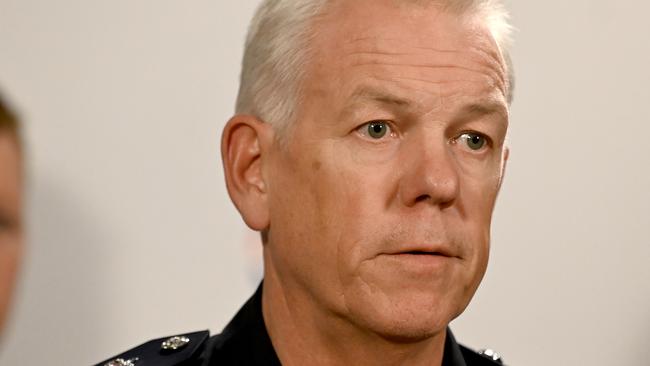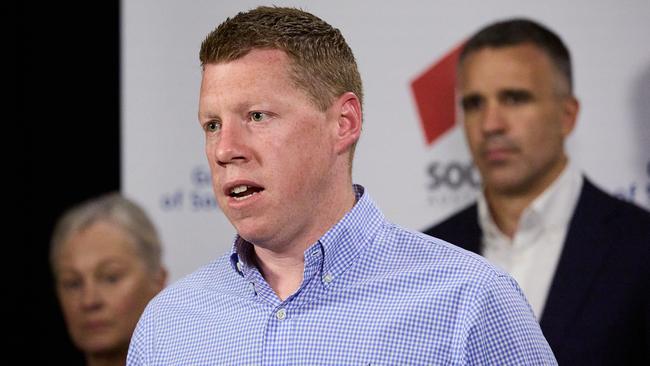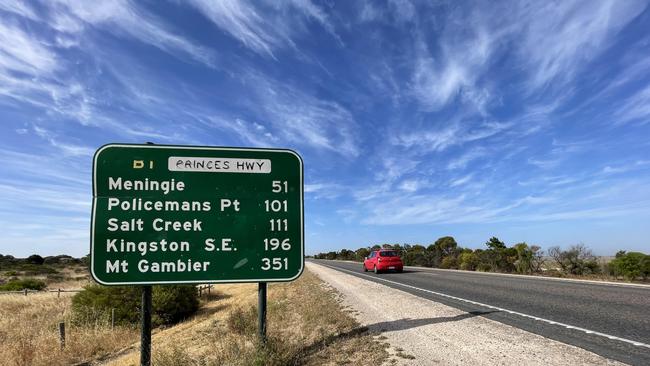Emergency declaration for SA floods extended, river restrictions to remain for now
The flood emergency declaration, which gives extra power to authorities, has been extended amid calls to ease “frustrating” restrictions for river residents.
SA News
Don't miss out on the headlines from SA News. Followed categories will be added to My News.
The state’s emergency minister says river restrictions won’t be eased yet, as the flood disaster’s emergency declaration – which gives extra power to authorities – is extended.
Emergency Minister Joe Szakacs says restrictions imposed for the River Murray flood event were reviewed at an Emergency Management Committee meeting on Monday, but would remain in place for now.
The state’s emergency declaration was extended on Monday for another 45 days, with Police Commissioner Grant Stevens to remain at the helm as state co-ordinator until early March.
The decision makes it the second-longest declaration in the state’s history – but it still falls far short of the 793 day declaration during Covid.
The emergency declaration centralises decision-making during disaster events and allows additional powers for a range of authorities.
Speaking to ABC Radio on Tuesday, Liberal Member for Chaffey Tim Whetstone called for the easing of restrictions for river communities as flows reduce to 135GL/day, down from 190GL/day.

“I think we have to be careful at how we do ease them, so that people can get back out and understand what the angst and anxiety has been all about,” Mr Whetstone said.
“People do take responsibility for themselves and they will go out on small craft … just to understand what this beast that’s come down the river means to them.”
Mr Szakacs said he understood river communities’ frustrations around restrictions, but the safety risk remained too great.
“Yesterday the premier chaired another meeting of the Emergency Management Committee, in which the police commissioner gave his advice that there still remains safety considerations that are fairly acute,” he said.
“We’re advised that water is flowing particularly fast at the moment and there is a very substantial amount of debris.”
“Not for one moment from the day these restrictions were imposed to the last restriction that is eased will I underestimate the frustration these are causing.
“I can absolutely see the frustration. But these restrictions were put in place by individual agencies responsible for the safety of our river.”
Economically the ‘worst natural disaster’ in state’s history
The restriction debate comes as the financial toll of the floods is revealed, potentially becoming the worst natural disaster in the state’s history with more than 3500 properties inundated with water.
The revelation comes as the State Emergency Service continue to assess the damage toll across riverside communities over the coming days.
The state and federal government have already invested close to $200m towards to assist businesses and residents impacted – the largest sum of money ever handed out for a natural disaster in Australia.
The peak finished passing through every South Australian town on Thursday and river flows are expected to drop to 60GL/day by the middle of February.
But as the state now enters the recovery phase, emergency services Minister Joe Szakacs indicated there would be more economic relief to come.
“It is entirely reasonable to say this will be one of the most, if not the most significant natural disaster in the state’s history,” he said.
“While we don’t know the total economic impact that these floods have had, it’s highly likely that they will be the most significant in our state’s history,” he said.

Mr Szakacs said there was a “big” task ahead to determine that impact.
“The damage caused, the water and inundation, is enormous,” he said.
“Roads and infrastructure – that are currently, in parts, still underwater – need to be assessed.”
More relief was offered to flood affected communities on Monday, with the state government announcing false fire alarm activation fees would be waived from December to March.
Between December 2021 to January 2022, River community businesses paid more than $8000 for false fire alarm activations by the CFS and $5000 by the MFS.
Mr Szakacs said the cost savings businesses will experience from waiving call out fees for false alarms will assist with recovery.
“Alarm fees range from about $450 and these alarms will be waived backdated to December of 2022, recognising that of course, this flood has had an impact now for many months,” he said.
Roads reopening
Meanwhile, a major highway connecting the inland to the South Australian coast reopened on Sunday after closing for less than 24 hours due to floodwaters.
The Department for Infrastructure and Transport closed the Princes Hwy between Tailem Bend and Meningie on Saturday night because of the rising water level, but quickly reversed that decision on Sunday morning.
Several low-lying sections adjacent to the Lower Lakes had been inundated on Saturday, however water levels receded overnight.
Road users were facing a detour via Coonalpyn on the Dukes Hwy and Mcintosh Way, adding about 64km to the journey.

It would have caused major disruption for holiday-makers as the highway serves as the main connecting route between the South Australia’s inland and the southeast coast.
A speed limit of 80km/h will be in place along between Tailem Bend and Meningie, while crews continue to monitor the situation.
Last week, Coorong District Council Mayor Paul Simmons said the detours would be in place to ensure Meningie was not cut off.
“The closure is in the area about 10 kilometres north of Meningie and it‘s not uncommon for a bit of water to come through … this is partially flood, partially wind and the tide,” he said.
Mr Simmons said the volume of trucks carting grain along the route would be higher than usual.
“There‘s a significant portion of farmers still going with their harvest, more so than normal in that particular area at this time of the year so some significant detouring will need to be done,” he said.
He said any highway closure would cause pain for commuters with the Wellington ferry out of operation and the Tailem Bend ferry likely to stop running any time soon.
Meanwhile, a major road connecting Riverland towns is expected to be closed for months due to flooding, causing businesses to lose customers who have been reluctant to travel along the extended detour.
Bookpurnong Rd, which connects the towns of Berri and Loxton, has been closed since December 1. The detour, via Stanitzki Rd to Sturt Hwy, through Paringa and Renmark and onto Old Sturt Hwy, Berri, takes twice as long and has been a thorn in the side of Loxton businesses who have had their profits slashed.




